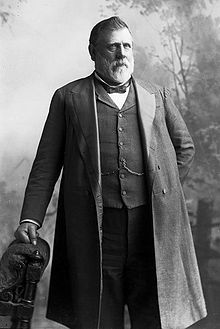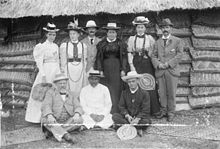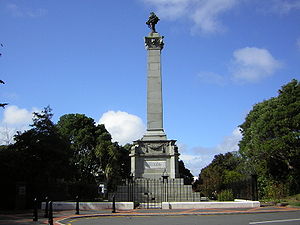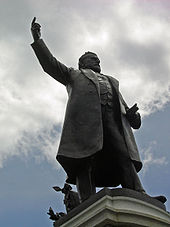- Richard Seddon
-
The Right Honourable
Richard John Seddon
MP
Rt. Hon. Richard Seddon in 1905. 15th Prime Minister of New Zealand[1] In office
27 April 1893 – 10 June 1906Monarch Queen Victoria
Edward VIIGovernor David Boyle
Uchter Knox
William PlunketPreceded by John Ballance Succeeded by William Hall-Jones Constituency Hokitika, Kumara, West Coast Personal details Born 22 June 1845
Eccleston, EnglandDied 10 June 1906 (aged 60)
At seaPolitical party Liberal Spouse(s) Louisa Jane Spotswood (m. 1869) Children 9 Religion Anglican Richard John Seddon (22 June 1845 – 10 June 1906), sometimes known as King Dick, is to date the longest serving Prime Minister of New Zealand. He is regarded by some, including historian Keith Sinclair, as one of New Zealand's greatest political leaders.
Contents
Early life
Seddon was born in Eccleston near St Helens in Lancashire, England in 1845. His father was a school headmaster, and his mother was a teacher. Despite this background, Seddon did not perform well at school, and was described as unruly. Despite his parents' attempt to give him a classical education, Seddon developed an interest in engineering, but was removed from school at age 12. After a short time working on his grandfather's farm at Barrow Nook Hall, Seddon was an apprentice at Daglish's Foundry in St Helens. He later worked at a foundry in Liverpool.
When he was 18 he emigrated to Australia, and entered the railway workshops at Melbourne. He was caught by the gold fever and went to Bendigo, where he spent some time in the diggings. He did not meet with any great success. In either 1865 or 1866, he became engaged to Louisa Jane Spotswood, but her family would not permit marriage until Seddon was more financially secure.
In 1866, Seddon moved to New Zealand's West Coast. Initially, he worked the goldfields in Waimea. He is believed to have prospered here, and he returned briefly to Melbourne to marry Louisa. He established a store, and then expanded his business to include the sale of alcohol, becoming a publican.
His parents were Thomas Seddon, born 1817, and Jane Lindsay who married on 8 February 1842 at Christ Church, Eccleston. Their children were:-
- Thomas born 1842, who died 1849
- Phoebe Ellen born 1843 died 1925 in New Zealand. Phoebe married William Cunliffe on 9 May 1863 at Holy Trinity Church Eccleston.
- Richard John born 1845, the subject of this article
- Edward Youd, born 1847 died 1919, Greymouth New Zealand
- William born 1849 died 1855
- Sarah Jane born 1853 died 1854
- James born 1854 died 1898
- Mary Jane born 1857 died young
Local politics
Seddon's first real involvement with politics was with various local bodies, such as the Arahura Road Board. He was later elected to the council of Westland Province, representing Arahura. Gradually, Seddon became known along the West Coast as an advocate for miners' rights and interests, and he was frequently consulted over various political issues.
In 1877, Seddon was elected as the first Mayor of Kumara, which was to become a prominent goldmining town. He had staked a claim in Kumara the previous year, and had shortly afterwards moved his business there. Despite occasional financial troubles (he filed for bankruptcy in 1878), his political career prospered.
Entry to Parliament
Parliament of New Zealand Years Term Electorate Party 1879–1881 7th Hokitika Independent 1881–1884 8th Kumara Independent 1884–1887 9th Kumara Independent 1887–1890 10th Kumara Independent 1890–1893 11th Westland Liberal 1893–1896 Liberal 1896–1899 Liberal 1899–1902 Liberal 1902–1905 Liberal 1905–1906 Liberal Seddon first sought election to the New Zealand Parliament in the 1876 elections, standing for the seat of Hokitika, but was unsuccessful. In the 1879 elections, he tried again, and was elected. He represented Hokitika to 1881, then Kumara from 1881 to 1890, then Westland from 1890 to 1906 (when he died).
In Parliament, Seddon aligned himself with George Grey, a former Governor turned Premier. Seddon later claimed to be particularly close to Grey, although some historians believe that this was an invention for political purposes. Initially, Seddon was derided by many members of Parliament, who mocked his "provincial" accent (which tended to drop the letter "h") and his lack of formal education. He nevertheless proved quite effective in Parliament, being particularly good at "stonewalling" certain legislation. His political focus remained largely confined to the West Coast, and he had little interest in many other matters.
Liberal Party
Seddon's first ministerial position was obtained when the Liberal Party, led by John Ballance, came to power in 1891. He may or may not have been offered various ministerial positions prior to this – if he was, he did not accept them.
Unlike Ballance, Seddon did not have any great commitment to philosophical liberalism – or, for that matter, to any ideology. Rather, he saw the Liberals as champions of "the common man" against large commercial interests and major landowners. His strong advocacy for what he saw as the interests of ordinary New Zealanders won him considerable popularity. Attacks by the opposition, which generally focused on his lack of education and sophistication (one opponent said of him that he was only "partially civilised") tended only to reinforce his new reputation as an enemy of elitism.
Seddon quickly became popular across the country. Some of his colleagues, however, were not as happy, accusing him of putting populism ahead of principle, and of being an anti-intellectual. John Ballance, now Premier, had a deep commitment to liberal causes such as women's suffrage and Māori rights, which Seddon was not always as enthusiastic about. Nevertheless, many people in the Liberal Party believed that Seddon's popularity was a huge asset for the party, and Seddon developed a substantial following.
Premiership
In 1892, Ballance fell seriously ill and made Seddon acting leader of the House. After Ballance's death in 1893, the Governor David Boyle, 7th Earl of Glasgow automatically asked Seddon to form a ministry. Despite the refusal of William Pember Reeves and Thomas Mackenzie to accept his leadership, Seddon managed to secure the backing of his Liberal Party colleagues as interim leader, with an understanding being reached that a full vote would occur when Parliament resumed sitting. Seddon's most prominent challenger was Robert Stout, who – like Ballance – had a strong belief in liberal principles. Ballance himself had preferred Stout as his successor, but had died before being able to secure this aim. Despite Seddon's promise, however, there was no vote – by convincing his party colleagues that a leadership contest would split the party in two, or at least leave deep divisions, Seddon managed to secure a permanent hold on the leadership. Stout continued to be one of his strongest critics.
Style of government
Seddon was a strong premier, and enforced his authority with great vigour. At one point, he even commented that "A president is all we require", and that Cabinet could be abolished. His opponents, both within the Liberal Party and in opposition, accused him of being an autocrat – the label "King Dick" was first applied to him at this point.
Seddon was also accused of cronyism – his friends and allies, particularly those from the West Coast, were given various political positions, while his enemies within the Liberal Party were frequently denied important office. Many of Seddon's appointees were not qualified for the positions that they received – Seddon valued loyalty above ability. One account, possibly apocryphal, claims that he installed an ally as a senior civil servant despite the man being illiterate. He was also accused of nepotism – in 1905, it was claimed that one of his sons had received an unauthorised payment, but this claim was proved false.
Seddon also accumulated a large number of portfolios for himself, including that of Minister of Finance (from which he displaced Joseph Ward), Minister of Labour (from which he displaced William Pember Reeves), Minister of Education, Minister of Defence, Minister of Native Affairs, and Minister of Immigration.
As Minister of Native Affairs, Seddon took a generally "sympathetic" but "paternalistic" approach. As Minister of Immigration, he was well known for his hostility to Chinese immigration – the so-called "Yellow Peril" was an important part of his populist rhetoric, and he compared Chinese people to monkeys. In his first political speech in 1879 he had declared New Zealand did not wish her shores to be "deluged with Asiatic Tartars. I would sooner address white men than these Chinese. You can't talk to them, you can't reason with them. All you can get from them is 'No savvy'."
Successive governments had also shown a lack of firmness in dealing with Maori, he said: "The colony, instead of importing Gatling guns with which to fight Maori, should wage war with locomotives" ... pushing through roads and railways and compulsorily purchasing "the land on both sides".[2]
Policy
One of the policies for which Seddon is most remembered is his Old-age Pensions Act of 1898, which established the basis of the welfare state built by Michael Joseph Savage and the Labour Party. The early Labour Party often claimed a certain affinity with Seddon on this basis. Seddon put considerable weight behind the scheme, despite considerable opposition from many quarters. Its successful passage is often seen as a testament to Seddon's political power and influence. Other socialist programs attributed to Seddon include pensions for teachers and moves to improve housing for workers.
Seddon's most notable failure to have his way, by contrast, was over the issue of women's suffrage. John Ballance, founder of the Liberal Party, had been a strong supporter of voting rights for women, declaring his belief in the "absolute equality of the sexes". Seddon, however, opposed women's suffrage. This resulted in considerable debate within the Liberal Party. Eventually, Seddon's opponents within the party managed to gather enough support for a women's suffrage bill to be passed despite Seddon's hostility. When Seddon realised that the passage of the bill was inevitable, he changed his position, claiming to accept the people's will. In actuality, however, he took strong measures to ensure that the Legislative Council would veto the bill, as it had done previously. Seddon's tactics in lobbying the Council were seen by many as underhand, and two Councillors, despite opposing suffrage, voted in favour of the bill in protest.
In the sphere of foreign policy, Seddon was a notable supporter of the British Empire. After he attended the Colonial Conference in London in 1897, he became known "as one of the pillars of British imperialism", and he was a strong supporter of the Second Boer War and of preferential trade between British colonies. He is also noted for his support of New Zealand's own "imperial" designs – Seddon believed that New Zealand should play a major role in the Pacific Islands as a "Britain of the South". Seddon's plans focused mainly on establishing New Zealand dominion over Fiji and Samoa, but in the end, only the Cook Islands came under New Zealand's control during his term in office. (Samoa later came under New Zealand rule as well, but Fiji did not).
Death
Seddon remained Prime Minister for 13 years, but gradually, calls for him to retire became more frequent. Various attempts to replace him with Joseph Ward met with failure. While on the Oswestry Grange ship returning from a trip to Australia, however, Seddon was suddenly taken ill, and died. He was buried in Wellington, with his grave being marked by a large monument.
Legacy
A statue of Seddon is located outside Parliament Buildings. A town in New Zealand and a suburb of Melbourne, Australia are named after him. His son Thomas replaced him as MP for Westland. Wellington Zoo was originally created when a young lion was presented to the late Prime Minister Richard Seddon by the Bostock and Wombwell Circus. Seddon created the Zoo from this single specimen and the lion was later named King Dick in the Prime Minister's honour. The stuffed body of King Dick (the lion) is displayed on the ground floor of the Museum of Wellington City & Sea.
References
- ^ The title "Prime Minister" was used by Richard Seddon after 1901, following New Zealand's self-exclusion from the Federation of Australia.See: "Prime Minister: The Title "Premier"". Te Ara – An Encyclopaedia of New Zealand, 1966. http://www.teara.govt.nz/1966/P/PrimeMinistersOfNewZealand/TheTitlepremier/en. Retrieved 27 August 2007.
- ^ "Ask That Mountain: The Story of Parihaka" by Dick Scott, Heinemann, 1975, Ch. 10.
The Duke of Argyll unveiled a memorial to Seddon in St.Paul's Cathedral,London, probably in 1910. It shows a portrait of Seddon with the inscription "TO THE MEMORY OF RICHARD JOHN SEDDON PRIME MINISTER OF NEW ZEALAND 1893–1906 IMPERIALIST STATESMAN REFORMER BORN JUNE 22nd 1845 AT St HELENS LANCASHIRE BURIED AT OBSERVATORY HILL WELLINGTON NEW ZEALAND"
External links
- Prime Ministers’ Office biography
- Sketch of Richard Seddon asleep in Parliament during an all-night sitting, 1898
- The Seddon-Stout struggle
- The Life and Work of Richard John Seddon by James Drummond, Whitcombe and Tombs Limited, 1907. Book-length biography, digitised by the New Zealand Electronic Text Centre.
Parliament of New Zealand Preceded by
Seymour Thorne George
Edmund BarffMember of Parliament for Hokitika
1879–1881
Served alongside: Robert Caldwell ReidSucceeded by
Gerald George FitzgeraldPremiers and Prime Ministers of New Zealand Sewell · Fox · Stafford · Domett · Whitaker · Weld · Waterhouse · Vogel · Pollen · Atkinson · Grey · Hall · Stout · Ballance · Seddon · Hall-Jones · Ward · Mackenzie · Massey · Bell · Coates · Forbes · Savage · Fraser · Holland · Holyoake · Nash · Marshall · Kirk · Rowling · Muldoon · Lange · Palmer · Moore · Bolger · Shipley · Clark · Key
Liberal Party of New Zealand Party leaders
Names in bold served as
Prime Minister of New ZealandJohn Ballance (1890 - 1893) · Richard Seddon (1893 - 1906) · William Hall-Jones (1906) · Joseph Ward (1906 - 1912) · Thomas Mackenzie (1912 - 1913) · Joseph Ward (1913 - 1919) · William MacDonald (1919 - 1920) · Thomas Wilford (1920 - 1925) · George Forbes (1925 - 1927) · Joseph Ward (1928 - 1930) · George Forbes (1930 - 1935)
Governments Related Articles Categories:- 1845 births
- 1906 deaths
- New Zealand people of English descent
- Mayors of places in New Zealand
- New Zealand gold prospectors
- New Zealand finance ministers
- New Zealand Liberal Party MPs
- New Zealand political party leaders
- People from St Helens, Merseyside
- Prime Ministers of New Zealand
- People from the West Coast Region
- New Zealand defence ministers
- New Zealand Liberal Party MLCs
- Burials at Bolton Street Cemetery
Wikimedia Foundation. 2010.




